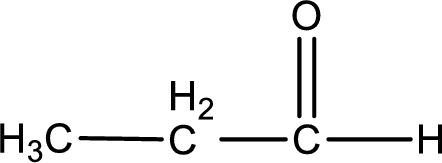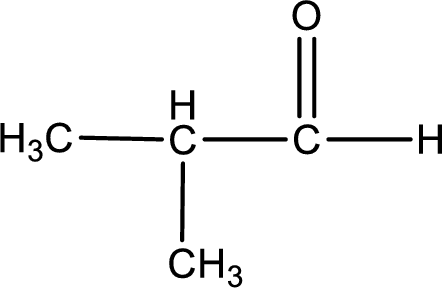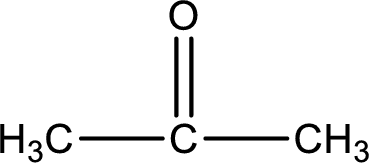
Concept explainers
What is the chemical formula of the inorganic product formed, if any, in each of the reactions in Problem 15-78?
- a. Propanal in the Tollens test
- b. 3-Pentanone in the Tollens test
- c. Methylpropanal in the Benedict’s test
- d. Propanone in the Benedict’s test
(a)
Interpretation:
The inorganic product formed when propanal undergoes Tollen’s test has to be given.
Concept Introduction:
In organic chemistry, oxidation reaction is referred to the number
In organic chemistry, reduction reaction is referred to the number
Alcohols undergo oxidation reaction and reduction reaction. This depends upon the number of hydrogen atoms that is bonded to the alpha carbon atom. Primary and secondary alcohol undergoes oxidation reaction while tertiary alcohol does not undergo oxidation reaction. Primary alcohols undergo oxidation to give aldehyde and carboxylic acid as product. Secondary alcohol undergoes oxidation to give ketone as the product.
Aldehyde undergoes oxidation to give carboxylic acid as the product while ketone does not undergo oxidation reaction.
Tollen’s test:
This is also known as silver mirror test. The reagent that is used in Tollen’s test is silver nitrate and ammonia in water. Aldehyde reacts with Tollen’s reagent, where the silver ion is reduced to silver metal and the aldehyde is oxidized to carboxylic acid.

Ketone does not undergo Tollen’s test to deposit silver metal.
Benedict’s test:
This test is also similar to Tollen’s test. In this test,

Answer to Problem 15.80EP
The inorganic product formed is silver metal.
Explanation of Solution
Aldehydes undergo Tollen’s test. The product formed when aldehyde undergo oxidation is a carboxylic acid. The general oxidation reaction for aldehyde can be given as,

Given aldehyde is propanal and the structure can be given as shown below,

This on reaction with Tollen’s reagent gives carboxylic acid and silver metal as the product. The structure of the inorganic product formed and the complete reaction can be given as shown below,

Silver metal is formed as the inorganic product when propanal undergoes Tollen’s test.
The inorganic product formed is given.
(b)
Interpretation:
The inorganic product formed when 3-pentanone undergoes Tollen’s test has to be given.
Concept Introduction:
In organic chemistry, oxidation reaction is referred to the number
In organic chemistry, reduction reaction is referred to the number
Alcohols undergo oxidation reaction and reduction reaction. This depends upon the number of hydrogen atoms that is bonded to the alpha carbon atom. Primary and secondary alcohol undergoes oxidation reaction while tertiary alcohol does not undergo oxidation reaction. Primary alcohols undergo oxidation to give aldehyde and carboxylic acid as product. Secondary alcohol undergoes oxidation to give ketone as the product.
Aldehyde undergoes oxidation to give carboxylic acid as the product while ketone does not undergo oxidation reaction.
Tollen’s test:
This is also known as silver mirror test. The reagent that is used in Tollen’s test is silver nitrate and ammonia in water. Aldehyde reacts with Tollen’s reagent, where the silver ion is reduced to silver metal and the aldehyde is oxidized to carboxylic acid.

Ketone does not undergo Tollen’s test to deposit silver metal.
Benedict’s test:
This test is also similar to Tollen’s test. In this test,

Answer to Problem 15.80EP
No inorganic product is obtained as 3-pentanone does not undergo Tollen’s test.
Explanation of Solution
Aldehydes undergo Tollen’s test. The product formed when aldehyde undergo oxidation is a carboxylic acid. The general oxidation reaction for aldehyde can be given as,

Given compound is a ketone that is 3-pentanone and the structure can be given as shown below,

This on reaction with Tollen’s reagent does not give oxidized product. Therefore, no reaction takes place when 3-pentanone reacts with Tollen’s reagent.

No inorganic product is formed when 3-pentanone undergoes Tollen’s test.
No reaction takes place when 3-pentanone undergoes Tollen’s test.
(c)
Interpretation:
The inorganic product formed when methylpropanal undergoes Benedict’s test has to be given.
Concept Introduction:
In organic chemistry, oxidation reaction is referred to the number
In organic chemistry, reduction reaction is referred to the number
Alcohols undergo oxidation reaction and reduction reaction. This depends upon the number of hydrogen atoms that is bonded to the alpha carbon atom. Primary and secondary alcohol undergoes oxidation reaction while tertiary alcohol does not undergo oxidation reaction. Primary alcohols undergo oxidation to give aldehyde and carboxylic acid as product. Secondary alcohol undergoes oxidation to give ketone as the product.
Aldehyde undergoes oxidation to give carboxylic acid as the product while ketone does not undergo oxidation reaction.
Tollen’s test:
This is also known as silver mirror test. The reagent that is used in Tollen’s test is silver nitrate and ammonia in water. Aldehyde reacts with Tollen’s reagent, where the silver ion is reduced to silver metal and the aldehyde is oxidized to carboxylic acid.

Ketone does not undergo Tollen’s test to deposit silver metal.
Benedict’s test:
This test is also similar to Tollen’s test. In this test,

Answer to Problem 15.80EP
The inorganic product formed is
Explanation of Solution
Aldehydes undergo Benedicts’s test. The product formed when aldehyde undergo oxidation is a carboxylic acid. The general oxidation reaction for aldehyde can be given as,

Given aldehyde is methylpropanal and the structure can be given as shown below,

This on reaction with Tollen’s reagent gives carboxylic acid and Copper(I) oxide as the product. The inorganic product formed and the complete reaction can be given as shown below,

The inorganic product formed when methylpropanal undergoes Benedict’s test is given.
(d)
Interpretation:
The inorganic product formed when propanone undergoes Benedict’s test has to be given.
Concept Introduction:
In organic chemistry, oxidation reaction is referred to the number
In organic chemistry, reduction reaction is referred to the number
Alcohols undergo oxidation reaction and reduction reaction. This depends upon the number of hydrogen atoms that is bonded to the alpha carbon atom. Primary and secondary alcohol undergoes oxidation reaction while tertiary alcohol does not undergo oxidation reaction. Primary alcohols undergo oxidation to give aldehyde and carboxylic acid as product. Secondary alcohol undergoes oxidation to give ketone as the product.
Aldehyde undergoes oxidation to give carboxylic acid as the product while ketone does not undergo oxidation reaction.
Tollen’s test:
This is also known as silver mirror test. The reagent that is used in Tollen’s test is silver nitrate and ammonia in water. Aldehyde reacts with Tollen’s reagent, where the silver ion is reduced to silver metal and the aldehyde is oxidized to carboxylic acid.

Ketone does not undergo Tollen’s test to deposit silver metal.
Benedict’s test:
This test is also similar to Tollen’s test. In this test,

Answer to Problem 15.80EP
No inorganic product is formed when propanone undergoes Benedict’s test.
Explanation of Solution
Aldehydes undergo Benedict’s test. The product formed when aldehyde undergo oxidation is a carboxylic acid. The general oxidation reaction for aldehyde can be given as,

Given compound is a ketone. The name of ketone is propanone and the structure can be given as shown below,

This on reaction with Benedict’s reagent does not give oxidized product. Therefore, no reaction takes place when propanone undergoes Benedict’s test.

No inorganic product is formed when propanone undergo Benedict’s test.
No reaction takes place when propanone undergoes Benedict’s test.
Want to see more full solutions like this?
Chapter 15 Solutions
General, Organic, and Biological Chemistry
- Discuss the results and observations in a regular laboratory experiments the denaturation of: 1. acetone 2. nitric acid 3. Heat 4. Acids 5. Saltsarrow_forward17. 1- Butanol was converted into butyl propanoate by reaction with an excess of propanoic acid. What is the name of this reaction? A. Acid-base reaction B. Base hydrolysis C. Acid hydrolysis D. Esterificationarrow_forwardWhat is the iodine indicator test used for? Describe in detail how iodine works in a reaction and what results are producedarrow_forward
- The following are the sugars that formed brick red precipitate during Barfoed's test, except:* A. GlucoseB. Fructose C. Lactose D. Galactose E. None of the given optionsarrow_forwardThe compounds 1-hexanol, 3-methyl-3-pentanol, hexanal, and 2-hexanone, and were used using different tests. Shown below is the schematic diagram of the tests performed on the compounds. Determine the identities of each compound based on the tests performed. a.) Compound A b.) Compound B c.) Compound C d.) Compound D Choices: I. 1-hexanol II. hexanal III. 2-hexanone IV. 3-methyl-3-pentanoarrow_forwardIndicate what you would do and the observations you would expect for each case. Be explicit in your explanations . Use simple chemical tests ( not including melting point, boiling point, spectroscopy, etc.) whenever possible and more elaborate tests for other cases. Describe how to distinguish between each of the following: A. 1-phenylpropyne and 3-phenylpropyne B. phenol and p-hydroxybenzyl alcoholarrow_forward
- Define the following terms briefly as they relate to the experiments Cite an example for each using the Fischer/Haworth projection formula a. Aldohexose b. Reducing Sugar c. Hemiacetalarrow_forwardA physician prescribes a prescription of Doriden, 325 mg, which requires you to prepare 30 capsules to be taken by a patient 1 hour before bedtime. Assuming that you will make a minimum of extra powder, how many tablets will you use to make this prescription? How many capsules will you calculate for? (Doriden is available in your pharmacy as a 500 mg tablet weighing 750 mg) Select one: a. 20 tablets, 30.77 capsules b. 19 tablets, 30 capsules c. 19 tablets, 32 capsules d. 20 tablets, 40 capsules What is the weight in grams of 1 Liter of alcohol (density, 0.816 g/mL? O O Oarrow_forwardAnswers 557 ldentify the Fischer projection A to D that matches each of the following: (15.1, 15.3) a the L enantiomer of mannose h a ketopentose C. an aldopentose d. a ketohexose CH,OH H. H HO- CH,OH C=0 H HO- H. OH C=0 H OH HO H. HO H. HO H. H--OH HO H- H OH HO CH;OH CH,OH CH,OH CH,OH C Darrow_forward
- Is this an drawing of the chemical reaction involved in Lugol’s test?arrow_forwardBelow is a formulation of 30mg/tab Primaquine Phosphate Tablet. You are required to compound 600, 000 pieces of this using the given formulation. Answer the questions. Formulation of Primaquine Phosphate Tablets, 30mg/ tab. Formula Mg/tab 30 Primaquine P04 Lactose Starch 56.6 16.6 PVP 0.57 0.23 Stearic Acid You are required to produce a batch of 600, 000 pieces of tablets. 1. Compute for the actual weight of each tablet. Your answer Formulation of Primaquine Phosphate Tablets, 30mg/ tab. Formula Mg/tab 30 Primaquine PO4 Lactose 56.6 Starch 16.6 PVP Stearic Acid 0.57 0.23 You are required to produce a batch of 600, 000 pieces of tablets. 2. Compute for the amount of each of the five (5) ingredients to be added during the compounding of the batch. (Answer should be in grams. Round the final answer up to 2 decimal places. Example: 43.89g) a) Primaquine PO4 b) Lactose c) Starch d) PVP e) Stearic Acid Your answerarrow_forwardA mixture containing glutamic acid, arginine, phenylalanine and valine was subjected to anion exchange chromatography at pH 7.0. Which of the amino acids interacted with the resin (anion exchanger) and last to be eluted with a buffer of decreasing pH? A. Glu B. Val C. Phe D. Argarrow_forward
 Human Anatomy & Physiology (11th Edition)BiologyISBN:9780134580999Author:Elaine N. Marieb, Katja N. HoehnPublisher:PEARSON
Human Anatomy & Physiology (11th Edition)BiologyISBN:9780134580999Author:Elaine N. Marieb, Katja N. HoehnPublisher:PEARSON Biology 2eBiologyISBN:9781947172517Author:Matthew Douglas, Jung Choi, Mary Ann ClarkPublisher:OpenStax
Biology 2eBiologyISBN:9781947172517Author:Matthew Douglas, Jung Choi, Mary Ann ClarkPublisher:OpenStax Anatomy & PhysiologyBiologyISBN:9781259398629Author:McKinley, Michael P., O'loughlin, Valerie Dean, Bidle, Theresa StouterPublisher:Mcgraw Hill Education,
Anatomy & PhysiologyBiologyISBN:9781259398629Author:McKinley, Michael P., O'loughlin, Valerie Dean, Bidle, Theresa StouterPublisher:Mcgraw Hill Education, Molecular Biology of the Cell (Sixth Edition)BiologyISBN:9780815344322Author:Bruce Alberts, Alexander D. Johnson, Julian Lewis, David Morgan, Martin Raff, Keith Roberts, Peter WalterPublisher:W. W. Norton & Company
Molecular Biology of the Cell (Sixth Edition)BiologyISBN:9780815344322Author:Bruce Alberts, Alexander D. Johnson, Julian Lewis, David Morgan, Martin Raff, Keith Roberts, Peter WalterPublisher:W. W. Norton & Company Laboratory Manual For Human Anatomy & PhysiologyBiologyISBN:9781260159363Author:Martin, Terry R., Prentice-craver, CynthiaPublisher:McGraw-Hill Publishing Co.
Laboratory Manual For Human Anatomy & PhysiologyBiologyISBN:9781260159363Author:Martin, Terry R., Prentice-craver, CynthiaPublisher:McGraw-Hill Publishing Co. Inquiry Into Life (16th Edition)BiologyISBN:9781260231700Author:Sylvia S. Mader, Michael WindelspechtPublisher:McGraw Hill Education
Inquiry Into Life (16th Edition)BiologyISBN:9781260231700Author:Sylvia S. Mader, Michael WindelspechtPublisher:McGraw Hill Education





